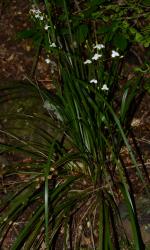- Taxon
- Gallery
- ≡ Sisyrinchium ixioides G.Forst., Fl. Ins. Austr. 61 (1786)
- ≡ Moraea ixioides (G.Forst.) Thunb. (1787)
- ≡ Ferraria ixioides (G.Forst.) Willd, Sp. Pl., ed. 4. 582 (1800)
- ≡ Nematostigma ixioides (G.Forst.) A.Dietr., Sp. Pl., ed. 6. 2, 509 (1833)
- = Libertia macrocarpa Klatt (1861 [1862])
- = Libertia tricolor Lem. (1863)
Plants consisting of leafy fans, close together on short, much branched rhizomes, joined by short stolons. Leaves (150–)550(–1160) mm × 3– 12 mm, the two surfaces similar; inclined to turn yellow where exposed to full sun; leaf bases pale redgreen; nerves many, median ones crowded to form pale midrib; margins often finely scabrid, leaf in transverse section convex lens-shaped, two rows of vascular bundles present, marginal vascular bundle present, sclerenchyma present on inside of leaf sheath. Peduncles long (2/3 the length of the inflorescence), but inflorescence short, usually not carrying flowers or fruits above leaves. Panicle narrow, but much branched, or sometimes simply branched; lower bracts long (50–410 mm), green, lanceolate, upper bracts narrow and pale brown, occurring singly; 1–6 flowers (often 2) per branch. Pedicels stout, 10–20(–28) mm long, glabrous. Flower bud sometimes yellowish, usually much smaller than ovary, flowers 8–15(–25) mm diam.; tepals all white internally, widely patent; outer tepals about ½ length of inner tepals and narrower, elliptical, flattened, with apiculus; inner tepals orbicular-elliptical, shortly unguiculate, not usually covering outer tepals, slight cleft at tips. Staminal filaments very shortly connate; anthers c. 2 mm long, yellow, pollen sacs broad, connective narrow; pollen ellipsoidal, monosulcate, 41.8–53.2 × 26.6–39.9 µm. Ovary pale, larger than perianth bud; style branches sometimes slightly winged, usually pointing outwards. Capsule (7–)15–25 mm long, 5–14 mm diam., barrel-shaped, ripening from green to yellow to black, partially dehiscing by short loculicidal splitting; old valves pale and not widely patent. Seeds 1–2 × 1–1.5 mm, rounded or occasionally angular, reticulate-foveolate, bright tangerine orange. FL Sep–Dec; FR Jan–Dec.
[Reproduced from Blanchon et al. (2002, New Zealand J. Bot. 40: 437–456) with permission from The Royal Society of New Zealand.]




